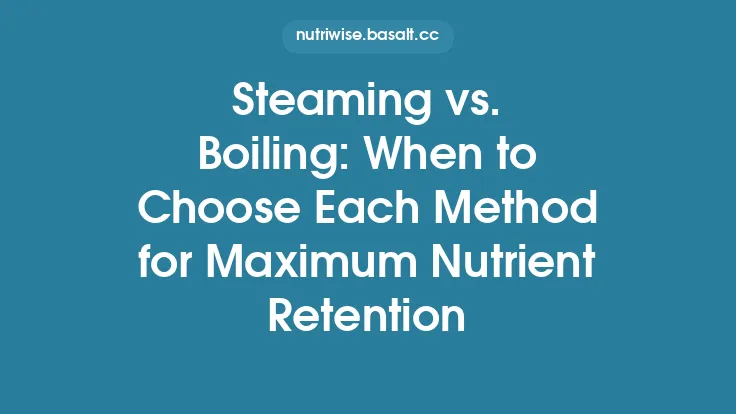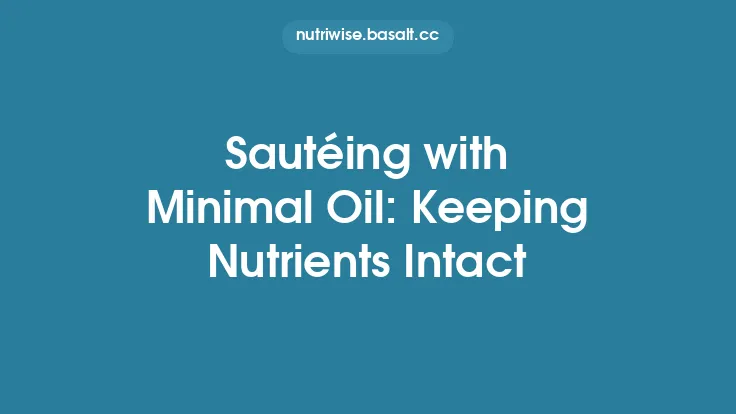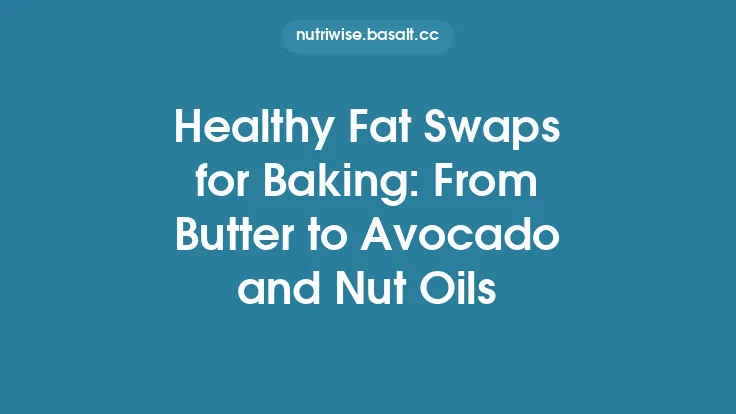Sautéing is one of the most versatile cooking methods in the kitchen, allowing you to quickly develop flavor, texture, and color while preserving the nutritional integrity of your ingredients. When the goal is to keep inflammation at bay, the choice of oil and the way you handle heat become critical. This article walks you through the science behind anti‑inflammatory oils, the practical steps for mastering healthful sautéing, and tips for integrating this technique into everyday meals without sacrificing taste.
Understanding Anti‑Inflammatory Oils
Anti‑inflammatory oils are rich in monounsaturated fatty acids (MUFAs) and polyunsaturated fatty acids (PUFAs) that have been shown to modulate inflammatory pathways. The most studied compounds include:
| Oil | Key Anti‑Inflammatory Components | Typical Ratio (MUFA:PUFA) |
|---|---|---|
| Extra‑virgin olive oil (EVOO) | Oleic acid, phenolic polyphenols (hydroxytyrosol, oleocanthal) | ~70:10 |
| Avocado oil | Oleic acid, lutein, phytosterols | ~70:12 |
| High‑oleic sunflower oil | Oleic acid, low linoleic acid | ~80:5 |
| Macadamia nut oil | Oleic acid, palmitoleic acid, tocotrienols | ~80:5 |
| Walnut oil (for finishing) | Alpha‑linolenic acid (ALA), ellagic acid | ~20:55 |
These oils differ not only in fatty‑acid composition but also in antioxidant content, which protects the oil from oxidative damage during cooking. Phenolic compounds in EVOO, for example, have been linked to reduced expression of cyclooxygenase‑2 (COX‑2) and lower levels of C‑reactive protein (CRP), both markers of systemic inflammation.
Choosing the Right Oil for Sautéing
While all the oils above have anti‑inflammatory properties, not every one is ideal for high‑heat sautéing. The primary considerations are:
- Smoke Point – The temperature at which the oil begins to break down and produce volatile compounds.
- Oxidative Stability – The oil’s resistance to forming harmful peroxides and aldehydes when heated.
- Flavor Profile – Some oils impart a distinct taste that may complement or clash with the dish.
Best Choices for Regular Sautéing (180‑210 °C / 350‑410 °F):
- High‑oleic olive oil (smoke point ~210 °C) – retains most of the phenolics while offering a mild olive flavor.
- Avocado oil (smoke point ~270 °C) – virtually neutral taste, excellent stability, great for a crisp sear.
- Refined (cold‑pressed) macadamia oil (smoke point ~230 °C) – buttery notes, high MUFA content.
Finishing Oils (added after cooking):
- Extra‑virgin olive oil – for a burst of polyphenols and flavor.
- Walnut oil – a drizzle over sautéed greens adds omega‑3s and a nutty aroma.
Smoke Point and Oxidative Stability: The Science
The smoke point is often misunderstood as a fixed value, but it varies with oil purity, age, and exposure to light. More importantly, the oxidative stability index (OSI)—the time an oil resists oxidation at a given temperature—provides a better gauge for healthful sautéing.
- High‑oleic oils have OSI values 2‑3× higher than standard olive or sunflower oil because the predominance of oleic acid (a monounsaturated fat) is less prone to peroxidation than polyunsaturated fats.
- Antioxidant content (tocopherols, phenolics) further extends the OSI. For instance, cold‑pressed avocado oil contains up to 30 mg/kg of tocopherols, which can delay the formation of aldehydes by up to 40 % at 180 °C.
Practical tip: Store oils in dark, airtight containers and use them within 6‑12 months of opening. Even a high‑quality oil will lose its antioxidant capacity over time, lowering its effective smoke point.
Preparing Ingredients for Optimal Nutrient Retention
- Uniform Cutting: Slice or dice vegetables and proteins to a consistent size (≈½‑1 cm). Uniform pieces cook evenly, reducing the need for prolonged exposure to heat.
- Pat Dry: Moisture on the surface of food creates steam, which lowers the pan temperature and encourages sogginess. Use paper towels or a clean kitchen cloth to blot excess water.
- Pre‑Season Lightly: Salt draws out moisture; if you season before sautéing, add only a pinch and consider a quick rinse afterward to avoid excess liquid.
- Layer Flavors Early: Aromatics such as garlic, ginger, or shallots should be added after the oil reaches the target temperature but before the main ingredient, allowing them to release volatile oils without burning.
Temperature Control and Timing
Step‑by‑Step Heat Management
| Stage | Temperature (°C/°F) | Action |
|---|---|---|
| Pre‑heat pan (dry) | 150‑160 °C / 300‑320 °F | Ensure even heat distribution; a drop of water should sizzle and evaporate instantly. |
| Add oil | 180‑190 °C / 350‑375 °F | Swirl to coat the surface; watch for a thin, steady shimmer. |
| Introduce aromatics | 180 °C / 350 °F | Stir for 15‑30 seconds; they should become fragrant, not brown. |
| Add main ingredient | 190‑200 °C / 375‑390 °F | Keep the food moving (toss or stir) to prevent localized overheating. |
| Finish & deglaze (optional) | 180 °C / 350 °F | Add a splash of broth, wine, or citrus to lift browned bits; this also halts further cooking. |
Why timing matters: Over‑cooking not only degrades texture but also accelerates lipid oxidation, producing compounds like 4‑hydroxynonenal (4‑HNE) that are pro‑inflammatory. A quick, high‑heat sauté (2‑5 minutes for most vegetables, 4‑6 minutes for thin cuts of meat) maximizes flavor while keeping oxidation low.
Pan Selection and Pre‑Heating Techniques
- Stainless Steel (Heavy‑Bottomed): Excellent for browning; requires a proper pre‑heat to create a temporary non‑stick surface.
- Carbon Steel: Similar to stainless but heats faster; develop a seasoned patina for added non‑stick properties.
- Cast Iron (Enameled): Retains heat well, ideal for dishes that start with sauté and finish with a brief oven bake.
- Non‑Stick (Ceramic Coated): Useful for delicate foods (e.g., fish) but avoid using metal utensils that can damage the coating.
Pre‑heat test: Drop a single grain of rice into the dry pan. If it sizzles and turns golden within 2‑3 seconds, the pan is ready. This method avoids the guesswork of visual cues alone.
Flavor Building Without Compromising Health
- Use Acid Early: A splash of lemon juice or a few drops of vinegar added midway through sautéing can brighten flavors and reduce the need for excess salt.
- Herb Infusion: Fresh herbs (thyme, rosemary, basil) can be tossed in during the last minute; their volatile oils are heat‑sensitive, so a brief exposure preserves their anti‑inflammatory compounds.
- Spice Toasting: Lightly toasting whole spices (cumin seeds, coriander) in the oil before adding the main ingredient releases essential oils without burning, enhancing both taste and antioxidant capacity.
- Umami Boosters: A modest amount of miso paste, tamari, or nutritional yeast adds depth, allowing you to finish with less oil or butter.
Combining Oils and Fat Sources
A strategic blend can marry the high smoke point of one oil with the robust phenolic profile of another:
- Base Oil (High‑Oleic) + Finishing Oil (Extra‑Virgin): Start sautéing with avocado oil, then drizzle EVOO just before serving.
- Butter‑Oil Emulsion: For dishes where a buttery flavor is desired, create a 1:1 ratio of clarified butter (ghee) to high‑oleic oil. Clarified butter raises the smoke point to ~250 °C, while the oil supplies MUFAs and antioxidants.
- Nut‑Oil Drizzle: A teaspoon of toasted sesame oil added at the end imparts a nutty aroma and supplies sesamol, a lignan with anti‑inflammatory activity.
Caution: Avoid mixing oils with vastly different smoke points in the same pan; the lower‑point oil will dictate the safe temperature and may degrade prematurely.
Cleaning and Maintaining Your Cookware
- Immediate Rinse: While the pan is still warm (not hot), rinse with hot water to prevent food from hardening onto the surface.
- Gentle Scrub: Use a non‑abrasive sponge and a small amount of mild dish soap; for stainless steel, a mixture of baking soda and water works well.
- Seasoning (Carbon Steel/Cast Iron): After cleaning, wipe the pan dry, apply a thin layer of high‑oleic oil, and heat briefly to polymerize the surface. This creates a natural non‑stick layer that also adds a protective barrier against oxidation.
- Avoid Dishwasher: The high heat and detergents can strip seasoning and promote rust on carbon steel or cast iron.
Common Mistakes and How to Avoid Them
| Mistake | Consequence | Solution |
|---|---|---|
| Overheating the oil | Formation of free radicals, off‑flavors, increased inflammation | Use a thermometer or visual cue (shimmer) and never let the oil smoke. |
| Crowding the pan | Steaming instead of sautéing, uneven cooking | Cook in batches; give each piece space to make contact with the hot surface. |
| Using old or improperly stored oil | Reduced antioxidant content, lower smoke point | Rotate oils regularly, store in dark glass, and label opening dates. |
| Adding wet ingredients directly | Temperature drop, oil splatter, loss of crispness | Pat dry or toss in a light coating of flour/cornstarch if appropriate. |
| Neglecting pan pre‑heat | Food sticks, uneven browning, longer cooking times | Allow the pan to reach the target temperature before adding oil. |
Practical Recipes and Variations
1. Mediterranean Sautéed Greens
- Oil: 1 Tbsp high‑oleic olive oil + ½ Tbsp extra‑virgin olive oil (finish)
- Ingredients: 4 cups kale, 1 cup baby spinach, 2 cloves garlic (thinly sliced), zest of 1 lemon, pinch of red‑pepper flakes, sea salt.
- Method: Pre‑heat pan, add oil, sauté garlic 20 seconds, add greens, toss for 2‑3 minutes until wilted, finish with lemon zest, extra‑virgin olive oil, and a squeeze of lemon juice.
2. Quick Shrimp & Avocado Oil Sauté
- Oil: 2 Tbsp avocado oil
- Ingredients: 300 g peeled shrimp, 1 tsp smoked paprika, ½ tsp cumin, 1 tsp minced ginger, 1 tsp lime zest, fresh cilantro.
- Method: Heat oil, add shrimp in a single layer, season, cook 1‑2 minutes per side, add ginger and spices, finish with lime zest and cilantro.
3. Tofu with Walnut‑Oil Finish
- Oil: 1 Tbsp high‑oleic sunflower oil (base) + 1 tsp walnut oil (finish)
- Ingredients: 200 g firm tofu (pressed, cubed), 1 tsp tamari, ½ tsp turmeric, 1 tsp sesame seeds, sliced bell peppers.
- Method: Sauté tofu until golden, add peppers, stir in tamari and turmeric, finish with walnut oil and toasted sesame seeds.
These recipes illustrate how a few simple adjustments—choice of oil, temperature control, and finishing touches—can transform everyday sautéed dishes into anti‑inflammatory power meals.
Bottom Line
Sautéing with anti‑inflammatory oils is less about exotic ingredients and more about mastering the fundamentals of heat, oil chemistry, and ingredient preparation. By selecting high‑oleic, antioxidant‑rich oils, respecting their smoke points, and employing precise temperature control, you can enjoy the crisp, caramelized flavors of sautéed foods while keeping oxidative stress—and thus inflammation—at bay. Incorporate these best practices into your routine, and your skillet will become a reliable ally in the pursuit of long‑term health and culinary delight.





